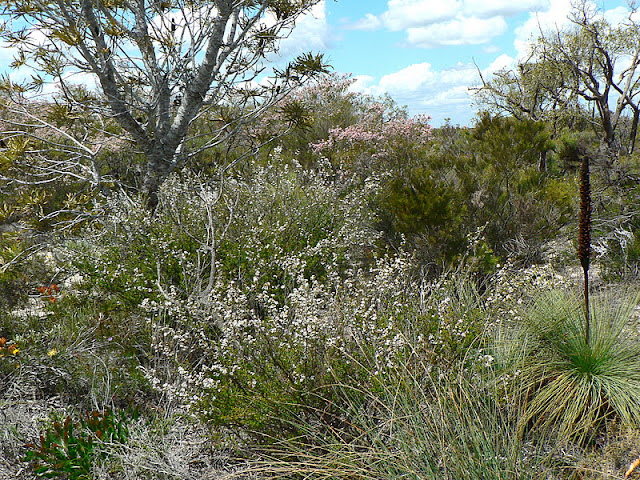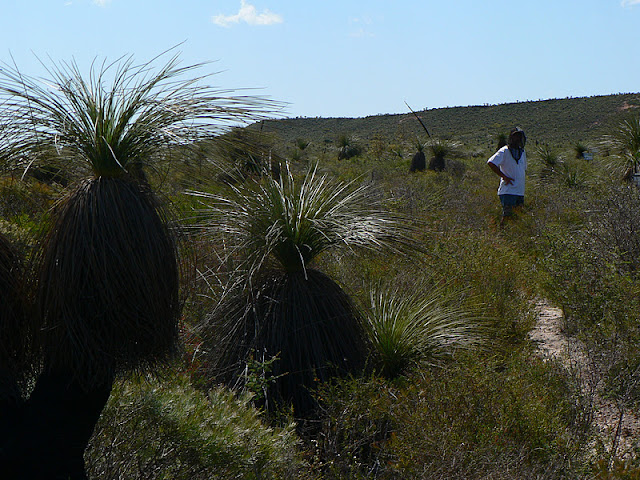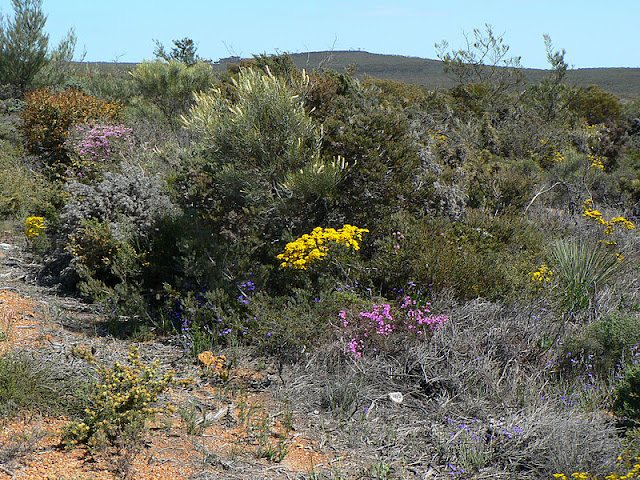I have taken to doing close up (macro) pics of the hundreds of flowers I see. I didn't realize how much I love looking at the different flowers WA has on offer. I'm always looking out for new flowers to photograph :)
The macro setting on my camera has been fun. A macro pic of a flower shows the flower differently & in most cases they look more gorgeous :)
I'm also amazed what the flower hides amongst its petals etc. Insects that can barely be seen with the naked eye showing up in the pic. There are flowers that are less than the size of a small fingernail & some pin head size looking bigger in the macro setting on the camera.
Some flower plants are just a few cms high out of the sandy soil.
We stayed at Western Flora van park the w/e of the footy grand finals. Rod could watch his footy on telly & I had a ball going on wildflower & bird searches amongst the dozens of hectares of regenerated property owned by some group like 'land care for wildlife'.
The property is just north of Eneabba - pronounced N - e - abba - about 100 kms inland from the coast & Geraldton & is surrounded by conservation / national parks etc, so it doesn't look out of place.
I'm all for these many national / conservation areas we passed through as there are hundreds of thousands of square kms of farming crops with little to no trees or other vegetation south & south east of about Kalbarri area.
Some areas of conservation was like driving through a flower garden - I couldn't get enough of it.
You will notice that a lot of the flowers have yellow stamens / centres. This is because insects are attracted to yellow & the plants have evolved over time to produce yellow centres for cross pollination. Flowers for bird attraction are usually red in colour.
Parts of western Flora had been controlled burned to avoid larger & more destructive fires that generate from lightening. The sections above were burned 18mths ago. It is amazing how many smaller flowers there are amongst the shrubs. The Banksias are burnt out here & are waiting to grow again from seed that needs fire to germinate.
This section was burned > 5yrs ago so it has many more higher growth shrubs including the Banksias. The colours in this area is amazing.
I have no idea what this plant is & wouldn't have taken any notice of it except that the owner of the property showed the tour group how sticky each individual flower is. The shiny spots on each flower is really sticky which attracts the insect to it where the plant then uses the insect for its food purposes.
Blue Leschenaultia grows every where & looks pretty in large clusters.
These 2 flowers are barely 2 - 3 cms out of the ground. The foliage next to the flower doesn't belong to that plant. The flowers are tiny as well & it is growing every where.
This shrub looks really pretty in full flower. I believe the flowers with the yellow stamens are the newer flowers on the shrub & are yet to pollinate insects.
This flower is my favourite of all that I've seen thus far. Called Fringed Lilly. It comes in 2 forms - a creeper over host shrubs, or a small plant with several stems. Doesn't it look exquisite?
as a creeper over a host shrub
small plant with several stems found much further south east of Western Flora.
Grass trees are a common plant in all areas south of Kalbarri - they regenerate really well after bush fires.
This pretty coloured plant is Cats Claw. It looks much like the Kangaroo Paw, but is smaller in stature & little leaf foliage other than what's on the flower stem. It grows in sandy soil & adds colour to the area.
Red Leschenaultia wasn't that commonly seen. I have a feeling that it is a type of 'trigger' plant. The stamen triggers down onto insects to pollinate when it lands on the flower. Smart plant!!
I think it's called a Granny Bonnet - I wonder why??
Looks like a type of lilly with several small flowers on the stems. It was growing every where in the more recently burned section @ Western Flora.
I was also taken by this plant. Called Verticordia (1 of many varieties) comes in many colours. This area was just the yellow / orange combination on the 1 plant. I especially loved the 'macro' image of the flower showing up its feather look.
I don't know, but I had no idea there was an insect hiding in the flower until the pic was on the computer.
1 sided Bottle Brush is the name of this shrub. The flowers don't go all the way around the stem
???
Grevillea - ? variety
Another Verticordia -Grandis - Feather Flower. Is in shrub form & likes the birds to pollinate I guess seeing as it's red
The red buds look amazing as well before bursting open - the flowers are produces on this plant alternately with the leaves.
Am not sure the name of these 2 plants, but it looks amazing up close with the golden tips.
This is a 'macro' shot of the Smoke Bush. Inside the black bits is the flower with it's stamen. The bush doesn't like ants being attracted to its nectar /pollen as ants don't pollinate to other plants. It also doesn't want the ant to go back to its nest & bring the whole crowd along. So the bush keeps the ant by holding onto it so it can never escape. That flower with the ant in it never has the opportunity to pollinate. ( how do I know this - we were shown the flower under a microscope with the ant in it :)
As you can see there are many thousands of opportunities on each shrub for pollination by other insects.
The Smoke Bush en mass.
I didn't know this insect was there on that flower until the pic was on the computer. I think this plant with its pretty flower is a Hakea variety. Not a good bush to brush past along a narrow track - spikes every where.
I think this may also be a Hakea by the look of the flower. The holly shape leaves are spikey also.
I don't know.......... but quite unusual
Almost paper thin petals.
A Banksia - maybe 'candle stick' variety - not quite in full flower yet though.
I have no idea what this is - it could even be a weed as many road side flowers like this are weeds as I've been told :( I think they looked pretty any way.
We found this tree growing in some one's yard in Badgingarra town when having lunch. It's called Mottlecah - showing before & after the flower comes out. Native to SW WA.
I found my 2nd orchid in the wild at a reserve east of Badgingarra. Looking like it's getting a little old, but gorgeous just the same. It goes by the name of Blue China Orchid. 1 single flower hiding under a bush.
Zamia Palm - an ancient cycad
Thinking maybe a Pixie mops variety ?
It's not a great look, but the flies are so bad in some parts of our travels we have to wear these important little numbers. Saves having the little buggers crawling up nares, eyes & mouth. They also tickle the .... out of you.
??
A eucalypt tree of unknown name in flower.
The Yellow Dryandra bush is quite prickly, but the flower looks quite delicate looking.
?? but it added colour
This is another tiny flower of approx 1 cm in size.
Am not absolutely sure, but I thought this unusual flower is from the 1 stem.
Another 1 cm size flower
Finally another orchid - we stopped near a granite rock / boulder (over 1 hectare in size) whilst driving along an alternative route towards Wave Rock. We took a short walk around the 'rock' & discovered a group of Granite Sun Orchids growing :)
Driving along the same alternative road, we passed many nature parks that had loads of colour. This plant was on the road verge & looked quite spectacular along with many other varieties of native bushes in flower.
Getting closer to Hyden & Wave Rock ( few hundred kms SE of Perth) we passed many dry & some wet salt lakes & ponds. There's a problem with salinity in the soil that has been under agriculture crops for over 100yrs. Many of the lakes have little vegetation ... apart from the occasional pig face succulent plant that likes that type of environment. At least it looks pretty.
Wave Rock is a granite outcrop of rock that takes on the appearance of a wave. Many plants love the granite rock type soil which is rich in nutrients. There were many outcrops of plants / shrubs on top of the large rock in concave areas that collects water to keep the plants alive.
Some plants like this growing in the shade are a mystery.
??
An orchid, but I don't know what it is. There were many different orchid varieties on & around the rock a few wks before our visit, but have since disappeared.
This Cowslip Orchid was a great find on the ground near a damp & shaded area on the ground level at Wave Rock.
Same variety, different flower & maybe different age of flower.
This little flower also looks like an orchid. It is so tiny I almost didn't see it. Less than 1 cm long & 0.5 cm wide. The flower is a creeper type plant.
I had troubel taking a pic of this flower as it is up side down. It's about the size of a thumb nail.
Plants will grow any where. There doesn't appear to be any soil around this shrub.
The 400 km drive towards Perth from Hyden was along another wildflower trail. The road sides were again very pretty. There was a couple of large salt lakes, hundreds of kms of fields of wheat crops etc, interspersed with many nature reserves (thank goodness) like this 1.
??
There weren't many tall trees in many of the areas. This flower shell belongs to the Eucalyptus family -Silver Princess, growing to about 5 mtrs tall. The branches etc are covered in a silvery / white powder. flowers are usually pink, so I think it would pretty in full flower.
Red Toothbrush Grevillea in 2 stages of flower.
The wildflowers of WA trail book that I was following in many areas gave descriptions that certain flowers could be found in certain areas / localities. Many times I was disappointed as the plant / many times orchids wasn't to be found. I had Rod stop in many areas any way just so I could have a look.
I would usually find other flowers though. I found many stems of the Granite Sun Orchid growing in 1 particular area, so I shouldn't complain.
In the same area as the above Sun Orchid, I found the following few unknown flowers
I have a setting on my camera where I can take a photo of a photo. It's like zooming in on an original photo. This flower looks really different - I think there's 2 flowers on the left of that bunch from the 1 stem. It's fingerlings make it look really unusual.
More Verticordia - white & yellow this time. I love the feather like feature of the flower.
We drove to yet another granite rock outcrop not far from Narrogin with the promise of finding more orchids. I didn't find any orchids, but I thought that this looked rather unusual. I'm not sure if the plant is alive, or it's a skeleton of a dead plant. Which ever it is, I think it looks amazing. EDIT 8/2021 - suggestion that this growth is Lacy Coral Lichen - cladia ferdinandii
Growing along the side of the road near Narrogin.
There was a small nature reserve across the road from our van park in Narrogin. There had been a small shower of rain a few hrs earlier when I took this photo of unknown plant.
Thank goodness for the many nature reserves, conservation parks & national parks.
The driving in WA hasn't been dull. There's been so much beauty along the roads, that's it's a wonder Rod hasn't taken to saying ...ENOUGH. He did say 1 day that there weren't any wildflowers south of Perth ....hahahaha
We visited Perth's Kings Park & Botanical Garden & I took many pics there as well.
I've been told there are many more flowers to be seen in the SW of WA.
It's my guess there may be another installment of wildflowers :)
If you know a flower name or I've labeled a flower wrongly, please let me know :))



























































































http://es.wikipedia.org/wiki/Freesia
ReplyDeleteHey Sue!Revisiting your blog, I was struck by the last white flower. In Spain there is a similar species: the freesia.Ithink she is it. It comes from South Africa and may be adapted to Australia,so the British Empire .
Here's the link in Spanish but you can translate it into English. So the two practice both languages.
Many regards . Franchesca
Hi Francesca. Many thanks for your link & info. I googled in English. Apparently this pretty flower is a Freesia. Originating from South Africa. It is now considered a "weed" in West Australia in the Southern parts around the wheat belt. It isn't noxious, but still on the weed list. Many plants or animals brought into Australia, when left to roam outside yard enclosures, becomes a pest. The cane toad was brought in to control the Cane Beetle. It didn't do the job, but is now roaming uncontrolled & reaching many parts of our beautiful country. Unfortunately it kills off our native frogs & many frogs are threatening extinction. The cane toad has poisonous glands & kills many animals including domestic pet dogs if they try to play with this noxious toad. Very sad indeed.
ReplyDeleteI don't think the flower I took a picture of had several on it's stem as in the googled information.
Thanks again
Sue
What can I say, thank you for these beautiful pics, have always wanted to see this spectacle, how long does it last and what is the best route and accommodation, moderately priced?
ReplyDeleteHi Evelyn
ReplyDeletethere are several routes to take. All of WA has wildflowers but it depends where you want to visit. I felt the best areas were south of Kalbarri. The trip can take as long as you want, but as we were touring in our caravan, we took our time. We explored Eneabba area beginning of October.
Information Centres in WA should have a booklet on routes to take & what to maybe expect to see. Information centres also should have information on where to stay. Most caravan parks have units / cabins to stay in, but I don't know of the costs. If you are from O/S, please be aware of some large distances between towns in Australia, depending on what part of the country you are visiting.
A Wildflower touring booklet may tell you the best times to see certain areas. Google Information Centre for perhaps Kalbarri & either email or phone them to see if they will send you a Wildflower touring booklet.
I hope this helps, but please don't hesitate to ask more questions if you need it. I may be able to help, but I don't live in WA - I'm on the other side of the country around Brisbane Queensland.
cheers
Sue
Sorry to ping such an old post.
ReplyDeleteI love the photos and wanted to say that the skeletal plant towards the bottom is coral lichen, maybe Cladia ferdinandii.
thankyou very much & for that info. I know very little about plant names. I looked up your suggestion & I shall edit my blog.cheers
ReplyDelete